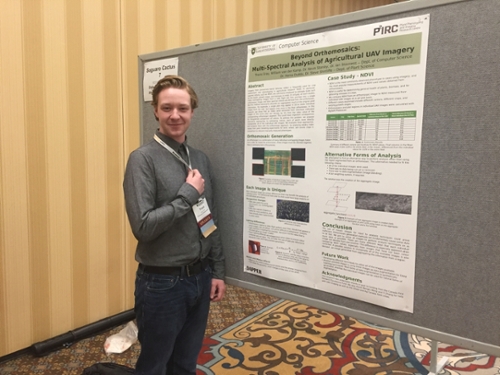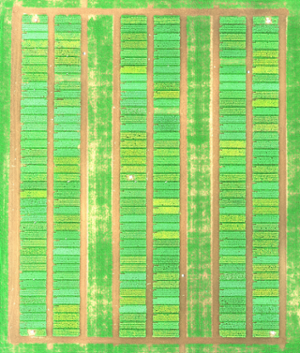
Profile: Travis Gray
Beyond Orthomosaics
Travis Gray, Masters Student in Computer Science (Project 3.2)
P2IRC Research: Multi-Image Analysis of Per-Plot Vegetative Indices from UAV Imagery
Can you tell me a bit about yourself?
I just finished up my first year of my masters working in the computer science lab with drone images of crops. I completed my undergraduate studies in computer science and grew up on a farm, so that’s how I became interested in what I’m doing. I like doing research that mixes computer science and my farming background, and its pictures of crops and drones!
Can you provide a brief summary of your research?
So, an orthomosaic is a big picture of a field where a bunch of little images are stitched together. I am looking at individual crop images taken from a drone and the analysis of these images, and comparing them to the analysis of a stitched together orthomosaic. This is a collaborative project with Steve Shirtliffe's Project 1.2 team, as they capture all the drone images in the field. I also work closely with William van der Kamp, the Research Associate for Project 3.2.
By comparing the individual images to the orthomosaic, I can use computation to analyze and compare traits, and see which differences exist between the two. Creating an orthomosaic is a long, costly process, and we’re ultimately looking to see if we have to create one.
What do you enjoy most about your research?
I like working with computer science but still being able to go out into the field and talk to people in the agricultural industry. I like to be able to explain my research to my dad and have him find it interesting and understand the applications of it.
Why is your project important?
For plant breeders, being able to accurately remote phenotype (select traits) would decrease the physical work required in the field and increase accuracy. However, remote phenotyping must be accurate in order for us to use it. We are working to make it more accurate, as well as efficient.

What are some potential applications of your project?
Stitching together an orthomosaic is costly in terms of time and money. My project focuses on a way to more efficiently use images taken by drones. Then farmers won’t have to get images stitched together but can run individual images through a program.
What was one of the biggest challenges you’ve faced as a researcher and how did you overcome it?
Almost all computer analysis of drone images use an orthomosaic specifically. So, one of the challenges I face is figuring out the best way to use individual photos, and also how to get researchers to understand that individual photos can perhaps be better than an orthomosaic. However, there are a number of agronomists thinking about the potential of what I do.
How have you grown or developed as a professional because of your research?
I’m a better programmer. I also work better in a development team. It’s a challenge to collaborate with people who might not understand computer science and to be able to get the right information from them about plant breeding in order to understand our work better. I’ve also learned how to present to people who don’t understand the computer science side and everything I’m doing, but I need to be able to present that information.
Phenome 2018 Conference: Gray, T., van der Kamp, W., Duddu, H. S., Shirtliffe, S., Eramian, M., Stanley, K. & Stavness, I. Beyond Orthomosaics: Multi-Image Spectral Analysis of Agricultural UAV Imagery. (2018). Phenome 2018 Conference.
Research Gate: Travis Gray

